I don’t know about you, but there’s something about belt sanders that fills me with pure joy. It might sound a bit sad, but honestly, the convenience, and beauty of these genius tools have always astounded me.
In this article we’ll be looking at the different types of belt sanders, and how and when to use them. We’ve also got reviews of the best belt sanders you can buy in Australia in 2024, just in case the rest wasn’t enough!
More...
Top Pick


Premium Choice

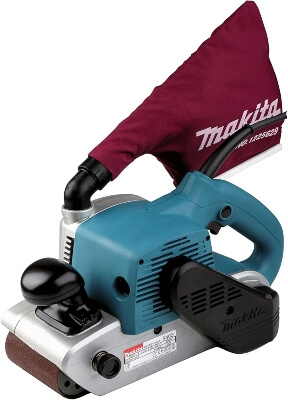
Best Value

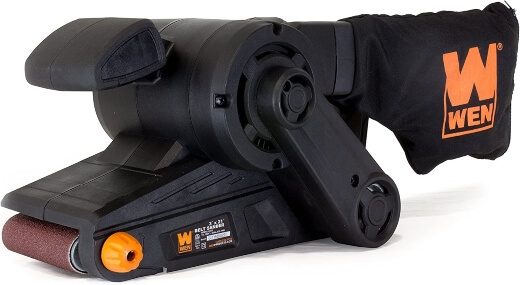
Product | Our Rating | Price | |
|---|---|---|---|
1. CRAFTSMAN CMEW213 Corded Belt Sander |  |  | |
2. Makita 9403J Corded Belt Sander | 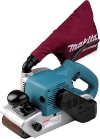 |  | |
3. WEN 6321 Corded Belt Sander |  |  | |
4. WEN 6524 Oscillating Belt and Spindle Sander |  | ||
5. Ryobi R18BS-0 ONE+ 18V Cordless Belt Sander |  | ||
6. Makita DBS180Z Cordless Belt Sander | |||
7. WEN 6307 Variable Speed Detailing File Sander |
Belt Sanders Buying Guide
What is a Belt Sander?

Belt sanders use a continuous roll of sandpaper set onto a fabric belt (often felted), which is attached to a set of mechanical rollers.
The resulting belt works like a conveyor belt in a supermarket, passing in one direction at all times to create perfect sanded edges on any timber surface.
In the article below, we’ll look in detail at the different types of belt sanders you can buy, from detail sanders to worktop bench sanders, but the fundamental operations of all of them are the same: Sanding belts; spinning wheels; safety guard.
When do you need a belt sander?
Belt sanders are best used for timber but can be used to finish acrylic or plastic projects, and even soft metals with the right belt attached.
We’ve used our belt sanders to add texture to copper garden ornaments, and even stone before, but timber is where they truly shine. For delicate woodwork, or piecing together those final few joins in a project, no joiner should be without one.
Even for DIY users, who often overlook belt sanders as part of their tool kit, if you’ve got kids, and you’re worried about splintering you can save yourself a surprising amount of time sanding corners to make spaces safer with belt sanders, without having to arduously scrape back sharp fittings with sandpaper.
Belt sanders might sound like a big investment, but they are cheaper than you might think, with an average price of $150, and budget models from as little as $60, so they really are worth considering even for DIY use.
What to Look for When Buying a Belt Sander
When buying any belt sander there are three things to look for (besides the type of belt sander itself). These include:
- Power supply
- Power
- Belt width
Below, we’ll look at each in detail, but essentially, higher power corded models are better suited to larger jobs, while cordless models are slower but more convenient.

Corded Vs Cordless Belt Sanders
The choice between corded and cordless tools is always contentious as cordless tools are sold for convenience, though many are sold either without batteries or have limited charge time, meaning regularly having to charge batteries before use.
Corded belt sanders are more powerful than cordless models and therefore work faster, while cordless models can be gentler, and produce neater results for novice users.
Power
Belt sanders are sold with a range of power, but what’s more important is speed. Power is a good gauge of speed, and also helps fight friction and maintain speed while sanding. Check both when buying a new belt sander.
Anything over 18V is usually adequate for a sanding timer.
Belt width
Belt width is important, particularly for detail sanders. Worktop belt sanders typically have wider belts, meaning they can sand the edges of larger timber, while fine belt sanders are designed for detail sanding, and clearing out joins so can often be as narrow as 9mm.
Different Types of Belt Sander
There are three types of belt sander; worktop, handheld, and detailing belt sander. All these have their uses, but handheld belt sanders are definitely the most versatile.
Personally, I prefer working with static tools so I’m moving my work, not the tool, but sometimes having the ability to take tools with you to sites overrides the safety of static tools. Below, we’ll look at the uses for each different type of belt sander.
Worktop Belt Sander
Worktop belt sanders are designed for safety. They attach firmly to workbenches and plug into the mains giving more power than most belt sanders.
Worktop bench sanders usually have variable speeds too, which is great if you’re new to belt sanding as it gives you slower settings to work with while you get used to the pace and angle of work.
Handheld Belt Sander
Handheld belt sanders are virtually identical to worktop bench sanders apart from that they are portable, and rather than moving your work along the static sanding belt, you move the belt sander around your work, ensuring all materials are firmly clamped or held in place before starting.
Handheld belt sanders tend to be narrower than worktop belt sanders for convenience, though many are flatbed so can be worked from side to side to cover wider surfaces.
Detailing Belt Sander
Detailing belt sanders are incredible tools for otherwise impossible jobs, but they are not part of most people’s toolkits because they are very limited in their purpose.
For filing between joins, or sanding down curves, they are hard to beat, but they’re not ideal for larger jobs.
How to Use a Belt Sander
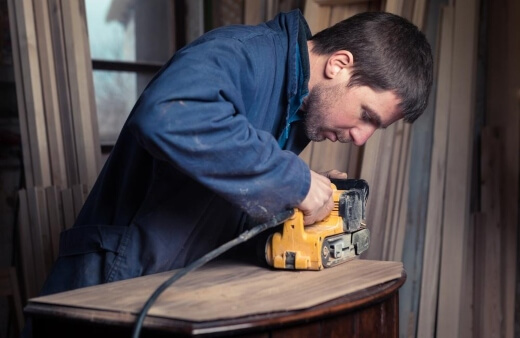
Belt sanders should always be used with minimal pressure, and materials working away from the sander. Hold materials firmly, but follow the direction of the sanding belt slowly.
Do not try to push against the sander, or add pressure as this will cause the belt to catch, snag or even tear. Always sand with the grain of the wood.
Sanding against the grain (at 90 degrees to the direction of lines on your timber) can completely ruin your work, and create worse snags and splinters than when you started.
Belt Sanders Safety Tips
Belt sanders are great tools but they come with tons of safety guidance. While you should always refer to the manufacturer’s safety guidance on any new power tools, we’ve got some basic safety rules for operating belt sanders below:
- Ensure the sander or materials are clamped in place before use.
- Always wear goggles
- Remove any jewellery before using belt sanders
- Have a second person present when possible to hit any safety switch, or turn off machines at the mains
- Tie your hair back
- Roll up your sleeves
Belt Sander Reviews
1. CRAFTSMAN CMEW213 Corded Belt Sander
The craftsman belt sander is something truly special, with a middle or road pricing, but a top-end design that makes it easy to change, simple to clean, and a delight to use.
This tool is perfectly balanced and feels safe on any material, but is best suited to hardwood timber. And on top of all that, it’s corded so it is quick to set up and ready to use whenever you are.
Pros
Cons
2. Makita 9403J Corded Belt Sander

Source: amazon.com.au
Makita always has, and hopefully always will make excellent tools. Their handheld belt sander is incredibly easy to use, really well balanced and comes with a free dust bag to extract the worst of the dust from the workspace.
The 100mm plate is ideal for most jobs and helps keep this sander to just the right size for weight and efficiency.
It’s also a corded tool which makes it really convenient for use without needing to charge up batteries (or as is the case with most tools these days – buy batteries separately).
Pros
Cons
3. WEN 6321 Corded Belt Sander

Source: amazon.com.au
WEN just love under-pricing everybody else, and they’re not changing their game here. This belt sander is well built, feels sturdy and well-balanced in most cases, and comes in at half the price of similar brands.
I’m really struggling to find a downside to this great value belt sander, and it even comes with a free dust bag too.
Pros
Cons
4. WEN 6524 Oscillating Belt and Spindle Sander
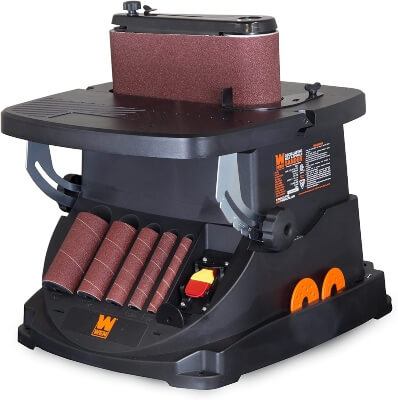
Source: amazon.com.au
I adore this worktop belt sander by WEN. It’s easy to set up, and even easier to use and by thinking a little differently about how belt sanders function, is incredibly safe too.
The vertical sanding belt means you get an additional horizontal guide, so you don’t need to add pressure to the belt, or the timber you’re working with to get good, even results.
Pros
Cons
5. Ryobi R18BS-0 ONE+ 18V Cordless Belt Sander
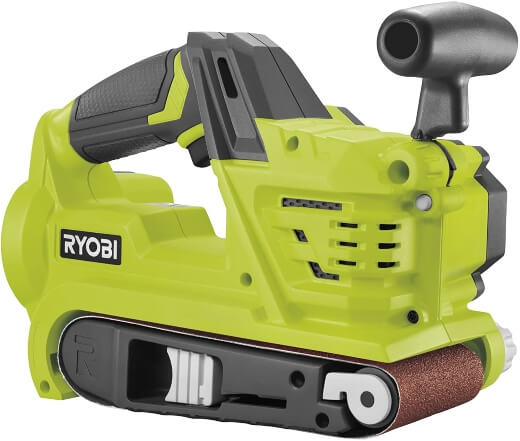
Source: amazon.com.au
Ryobi makes reliable tools, but they’re not known for their value. This corded belt sander is perfect for anyone with a range of Ryobi tools already, but doesn’t come with a battery included so it has added expenses.
The tool itself is perfectly alright and works well, but I have to admit I find it hard to get excited with this basic belt sander.
Pros
Cons
6. Makita DBS180Z Cordless Belt Sander

Source: amazon.com.au
For those finishing touches, whether it’s neatening up joints, or sanding down final splinters, this accurate fine belt sander is perfect for professional joiners, but priced for DIY users.
If you’re after a tool you can trust and know what you’re doing, this has to be the best detail belt sander we can find, and it includes great safety features for added control like the extra T-handle.
Pros
Cons
7. WEN 6307 Variable Speed Detailing File Sander

Source: amazon.com.au
If you’re looking for a really good budget tool for general purpose sanding, and you’re not fussed about getting everything perfectly flush, then try something like this detail sander from WEN.
It’s not ideal for large jobs, but for quick touch-ups at the end of a project, it’s super convenient and insanely cheap.
Pros
Cons
Belt Sander Top Picks for 2024
Our Top Pick Belt Sander


Source: amazon.com.au
Craftsman tools are just outstanding sometimes. They look good, they feel good, and they work. Oh, and did we mention that this belt sander from Craftsman is great value too? I’m not sure what more you could want, but just in case, it’s also incredibly comfortable to use.
If you’re new to belt sanders and want something you can trust without having to spend really big money, then try the Craftsman belt sander, with this 3” belt – perfect for almost any job.
Premium Choice Belt Sander


Source: amazon.com.au
Makita’s high-quality belt sander really is the best belt sander we’ve got on review here, with a solid body, sturdy handle, and even pressure across the sanding surface it’s everything you want, and even includes a dust bag for convenience.
Best Value Belt Sander


Source: amazon.com.au
Taking things down a price tag or two, we’ve got our best value belt sander; the WEN 6321 Corded Belt Sander. These belt sanders come with a dust bag and sanding belt, and are corded for convenience.
If you’re trying belt sanders for the first time and don’t want to invest in more expensive tools, this is a great place to start. WEN are a reliable manufacturer, with trusted tools sold all over the world, and this belt sander is everything their reputation promises.
Belt Sander Frequently Asked Questions
Is a belt sander better than an orbital sander?
Belt sanders and orbital sanders are built for different purposes, so neither is better or worse than the other. For sanding corners and finishing edges, belt sanders are the better tool. For smoothing flat surfaces, orbital sanders are the best tool.
Check out our in-depth buying guide for orbital sanders in Australia for more info.
Are belt sanders worth the money?
Belt sanders are definitely worth the money as the only tool for quickly smoothing the finishing edges of any timber work.
It’s definitely true that you can do anything a belt sander can do by hand, but you will save a massive amount of time and (provided you brush off the sander after use) money on sandpaper with a belt sander.
How long do belt sander belts last?
Sanding belts typically last for around 12 months with standard use, but it entirely depends on how often they are used, the materials they are used for, and whether or not you brush out the sanding belt after each use.
Generally, sanding belts will last for around 100 uses, but change them if the grain begins to wear.
Having the right tools is essential especially for DIYers. Be sure to check out our list of buying guides below:

Make Your DIY Projects Easier by Using Only the Best Belt Sanders for 2024
There is no tool that can do the job of a belt sander as efficiently, or as neatly as a belt sander. While buying the best belt sander isn’t straightforward, there are definitely a few stand-out models on the market right now, so remember to check our reviews when you’re ready to buy your own belt sander to get the best value for money.
Published on June 28, 2022 by Gary Clarke
Last Updated on January 11, 2024




